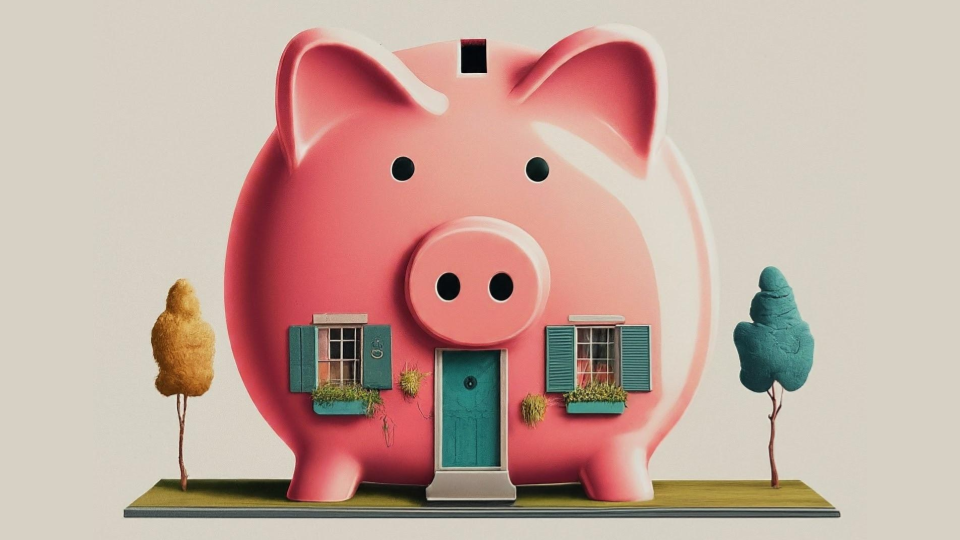
7 Ways To Access Your Home Equity in Canada
Whether you want to retire comfortably, renovate your home, consolidate debt, start a business, help your kids with a down payment on their first home or diversify your investments, the equity in your home could be the key to making your financial goals a reality.
Canadian homeowners have built up a staggering amount of home equity: almost $4.7 trillion in early 2024.1 For the median home-owning household in Canada, home equity represents between half and two-thirds of their net worth,2 making it their largest single asset by a wide margin. If you own your home, you might be wondering how you can tap into this wealth to give yourself financial flexibility. Let’s explore your seven options for doing just that.
But first, what is home equity? Your home equity is the market value of your stake in your home. To calculate it, start with the market value of your home and subtract all amounts that you owe that have been secured against your home, like a mortgage. For example, if your home is appraised for $700,000 and your mortgage balance is $400,000, then you have $300,000 in home equity.
Unlike liquid assets like publicly traded stocks and bonds that can be converted into cash easily, tapping into your home equity requires more planning. Unless you’re selling your home outright, accessing your home equity entails using your home as collateral. Traditionally, this meant using your home as collateral for debt, like a mortgage. Many of the options we cover below are debt products, like a home equity line of credit. Canadian homeowners now have a new option to tap into their home equity without taking on debt or selling: a Home Equity Sharing Agreement (HESA, rhymes with ‘visa’) from Clay Financial. A HESA is still secured against your home but it’s not debt. Instead, the amount you pay is based on how much your home has appreciated. You can read about all of these options, including our HESA, below!
1. Sell Your Home
The Lowdown: Selling is the most straightforward way to unlock all of your home equity. This gives you maximum flexibility to reinvest the proceeds as needed.
The Catch: Selling involves significant costs, including realtor commissions, legal fees, moving expenses and potential prepayment penalties on your mortgage. Plus, you may not want to leave your home yet – leaving behind the home and community you love can be emotionally difficult. You’ll still need to live somewhere and so, after all of the costs, you may not free up much of your equity if you buy another home. Renting your next home can free up much more equity but rent payments will be a new monthly payment obligation and will increase over time.
Best for: Homeowners who are ready for a major change, like downsizing or relocating, or those who require a large sum of money for significant life plans.
2. Home Equity Line of Credit (HELOC)
The Lowdown: A HELOC functions a bit like a credit card backed by your home. You receive a credit limit and pay interest only on what you use, offering flexibility over when and how much you borrow. You get to decide how quickly to pay back the principal amount borrowed.
The Catch: With a HELOC, you must pay the interest owing each month at a minimum. Most HELOCs have variable interest rates, meaning your payments could rise unexpectedly. A HELOC may have closing costs similar to a mortgage depending on your lender and how recently your home was appraised.
Best for: Homeowners with good credit that can afford monthly payments who need funds over time for projects like renovations or to help cover unpredictable costs.
3. Home Equity Loan
The Lowdown: A home equity loan provides a lump sum of cash with a fixed or variable interest rate and a regular repayment schedule. If you already have a mortgage, you may also hear this product referred to as a second mortgage.
The Catch: You’ll be required to make payments of principal and interest every month. If you choose a variable rate, your payment amount may change unexpectedly. Even if you choose a fixed rate, you may be forced to refinance the loan at a higher rate on maturity if you can’t pay the full amount back. Home equity loans can have closing costs similar to a mortgage.
Best for: Homeowners looking to fund a one-time expense like a major renovation or debt consolidation who are comfortable making monthly payments of principal and interest.
4. Cash-out Refinancing
The Lowdown: Replace your existing mortgage with a larger one, pocketing the difference in cash. You may get a better interest rate than other loan options since it becomes your new first mortgage.
The Catch: You’ll incur refinancing costs and potentially mortgage prepayment penalties on your original mortgage. You’ll also be extending your mortgage term and increasing your total debt, likely resulting in larger monthly payments of principal and interest.
Best for: Homeowners looking to access a moderate amount of equity who are comfortable taking on a larger monthly mortgage payment. May be of particular interest to homeowners when interest rates have fallen since they entered into their current mortgage.
5. Reverse Mortgage
The Lowdown: A reverse mortgage allows seniors (age 55+) to borrow against their equity without monthly payments. Interest accrues in the background, compounding every month over the term of the loan. You make a lump-sum repayment at the end of the loan, typically when you sell your home, move, pass away or if you don’t renew the reverse mortgage at the end of its current term (usually 5 years or less). Reverse mortgages are unique among debt products in that you’re able to stay in your home for the rest of your life provided you’re in compliance with the terms of your loan agreement. Reverse mortgages in Canada often come with guarantees that you’ll never owe more than the value of your home.
The Catch: Reverse mortgages generally have higher interest rates and fees than traditional mortgage loans, as you pay a premium to avoid monthly payments. You usually can’t combine a reverse mortgage with other secured debts like mortgages and HELOCs, so you may have to get a larger reverse mortgage to pay off those balances before you can access your equity. A reverse mortgage erodes your equity in your home when the compounding interest grows faster than the rate at which your home appreciates. Interest will grow faster when interest rates are higher. Even if you secure a fixed-rate reverse mortgage, interest rates may be higher when it comes time to renew.
Best for: Seniors who do not want monthly payment obligations but are comfortable with debt, need to supplement their retirement income and want to remain in their homes for the rest of their lives. May be a compelling option if you believe the value of your home will increase faster than the compounding interest that accrues over the term of the reverse mortgage.
6. No-payment Mortgage
The Lowdown: Some private lenders offer no-payment mortgages that are similar to reverse mortgages but without the age restriction and the guarantee that you won’t owe anything until you sell, move or pass away. A variety of terms are available depending on the lender, typically ranging from 1 to 5 years. Since there are no monthly payments, accrued interest is added to the loan’s balance every month and then the next month’s interest is calculated based on that larger balance. You must make a lump-sum repayment at the end of the loan’s term unless you’re able to renew it for another term.
The Catch: Similar to a reverse mortgage, a no-payment mortgage usually comes with a higher interest rate, higher fees and an inability to combine it with other secured debt. If you already have a mortgage or HELOC with a lower interest rate, you’ll likely have to give it up and refinance the balance using this more expensive option. As with a reverse mortgage, homeowners should be aware of the risk that compounding interest could erode their equity. Since a no-payment mortgage does not auto-renew, you’ll have to make a lump-sum repayment at the end of the term unless your lender allows you to renew the loan based on the amount of equity you have left. If you don’t have enough equity and aren’t able to refinance the loan with another lender, you’ll likely be required to sell your home in order to repay the loan.
Best for: Homeowners with reduced cash flow looking for liquidity and a short-term reprieve from payments. As with a reverse mortgage, a no-payment mortgage may be a compelling option if you believe the value of your home will increase faster than the compounding interest that accrues over its term. Homeowners should be comfortable with the possibility of having to sell their home within the next five years in order to make the lump-sum payment.
7. Home Equity Sharing Agreement (HESA)
The Lowdown: A HESA is a financial contract offered by Clay Financial that lets you access some of your home equity without taking on debt. We provide a lump-sum cash payment at the start of the HESA and, in exchange, you share some of the future increase (or decrease) in the value of your home with us. A HESA has a flexible term up to 25 years, ending when you sell, choose to buy it out or pass away. There are no monthly payments, no age restrictions and no risk of eroding your existing equity. You make a single payment to us at the end of the HESA based on the amount of equity you accessed initially and our share of your home’s appreciation since the start of the HESA.3 If you have enough equity, a HESA can be combined with existing debt products like a mortgage and HELOC, giving you greater flexibility.
The Catch: You’re sharing some of your home’s future appreciation with us. The final repayment amount depends on your home’s value at the end of the HESA term, which is impossible to know in advance. If home prices appreciate significantly over the term of a HESA, the HESA could be more expensive than a debt product. Conversely, if home prices do not appreciate as quickly, or if interest rates are high, a HESA could be a better option than some debt products.
Best for: Homeowners who want the long-term financial flexibility of tapping into their equity without making monthly payments, taking on debt or selling their home. May be a compelling option if you aren’t sure what home prices and interest rates will do in the future.
Which option is best for you?
The answer depends on your financial situation, goals and risk tolerance. A financial advisor can help you evaluate the pros and cons of each option to make the best decision for your needs.
If you’re comparing a HESA to the many debt options, start by getting an estimate of how much equity you may be able to access with a HESA from Clay Financial.
1. Based on analysis of home value data from the Canadian Real Estate Association, home ownership data from Statistics Canada and household debt data from Statistics Canada.
2. Based on the analysis described in footnote #1 as well as analysis of household wealth data from Statistics Canada.
3. Try our HESA Calculator to see what the payment could be at the end of a HESA in different scenarios.


